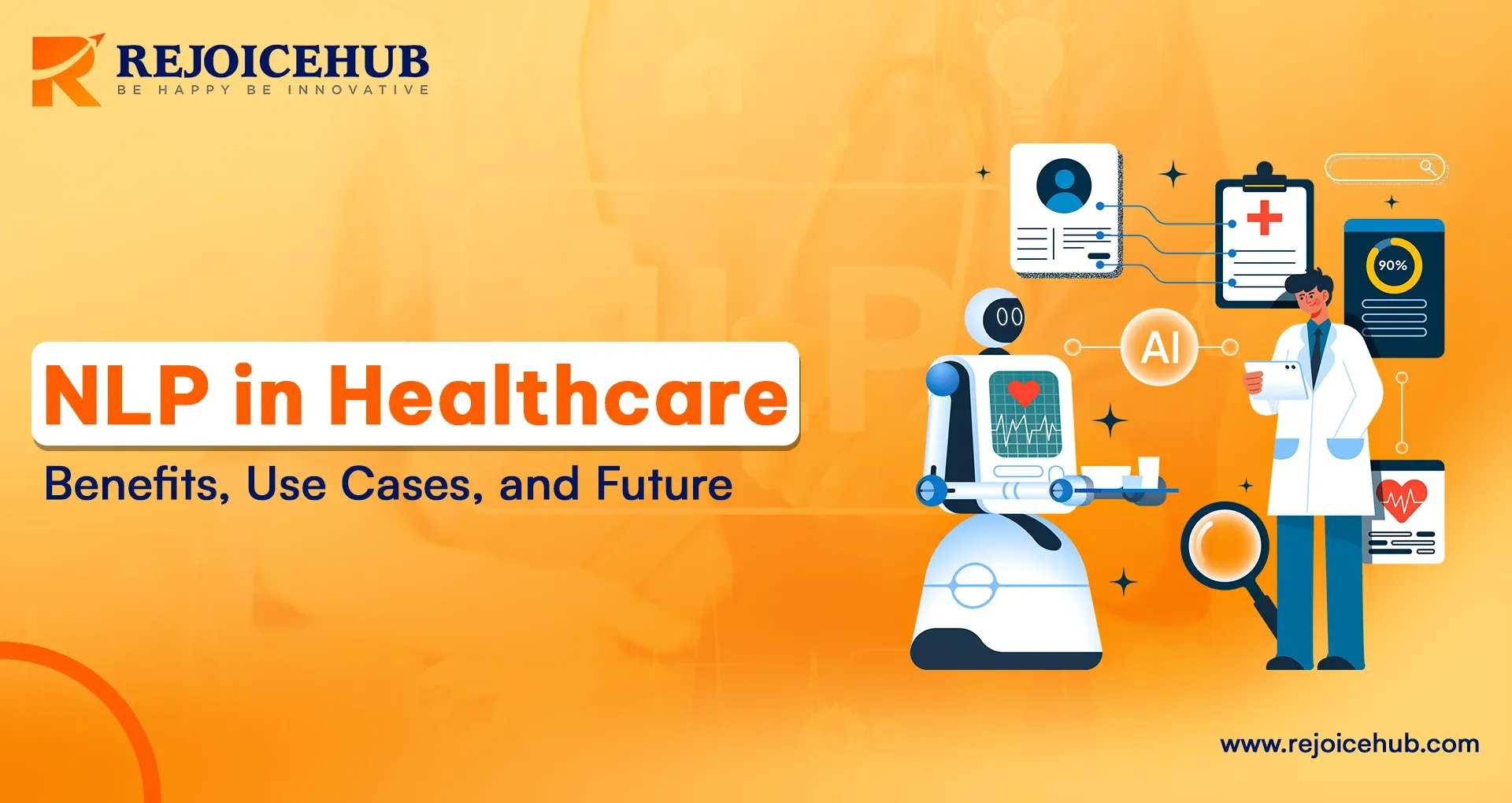
If you work in hospitals or any healthcare department, you must have noticed that AI and machines are being used extensively for every task and operation, so that management can be kept smoother and digital, without lengthy manual medical records.
In the healthcare sector, apart from management, AI is also used for many important operations like appointment scheduling or free patient customer support, and dedicated NLP is extensively used to make AI understandable for humans.
Just last week, I was talking to a cardiologist friend of mine, who told me that AI and NLP have brought a lot of revolution in the medical industry. AI is used for disease detection and even in critical diagnosis machines like MRI or CT scans.
Such widespread use of Artificial Intelligence in the healthcare sector has been possible to a large extent due to the use of Natural Language Processing (NLP); hence, today we will learn in detail about NLP used in healthcare.
Quick Summary
In the last few years, healthcare organizations like Mayo Clinic and Texas Heart organization have been using NLP and Machine Learning extensively for research and diagnosis. Furthermore, the involvement of Artificial Intelligence in EHR (Electronic Health Record) systems has increased significantly. NLP is playing a vital role in the deep analysis of medical records and sharing these medical records with all healthcare hospitals in real-time.
In the healthcare sector, it transforms raw clinical text and speech into structured, actionable insights, which makes it possible to provide appropriate treatment to patients and also speeds up medical research, as symptoms of all new diseases become readily available to researchers globally.
Our Focus in this article!
1. What is NLP, and how does it work?
2. What are the use cases of NLP in the healthcare sector?
3. What benefits do healthcare sectors receive from NLP and AI?
4. We will also discuss future trends of NLP and its application to current healthcare challenges.
What is Natural Language Processing (NLP)?
You can call NLP (Natural Language Processing) a kind of technology that connects humans and artificial intelligence-based chatbots.
Since human languages are quite unstructured, containing a lot of slang, sentences and sarcasm, Artificial intelligence based machines or agents can only process structured data and give results, and this is why NLP is used to bridge the gap between humans and machines. Compared to simple keyword searches, NLP algorithms analyze the context and meaning of text or speech.
In the medical sector, NLP transforms unstructured medical notes, lab reports, and even call centre transcripts into structured data that doctors and researchers can understand and act on.
Modern NLP relies heavily on machine learning and deep learning models, which improve over time.
For example, large language models, such as Google's Med-Palm or OpenAI's GPT-40, can now summarise complex clinical notes with impressive accuracy. Doctors often combine these techniques to use Named entity recognition (NER) (to identify diseases, drugs, and test names) and sentiment analysis (to gauge patient feedback).
This allows healthcare teams to spend less time on diagnostics, significantly speeding up patient care.
Key Use Cases of NLP in Healthcare
NLP is being used in many industries, and ever since dedicated NLP types have come into the market, healthcare organizations have also started implementing NLP in their systems. Let us know about its key use cases in healthcare sector.
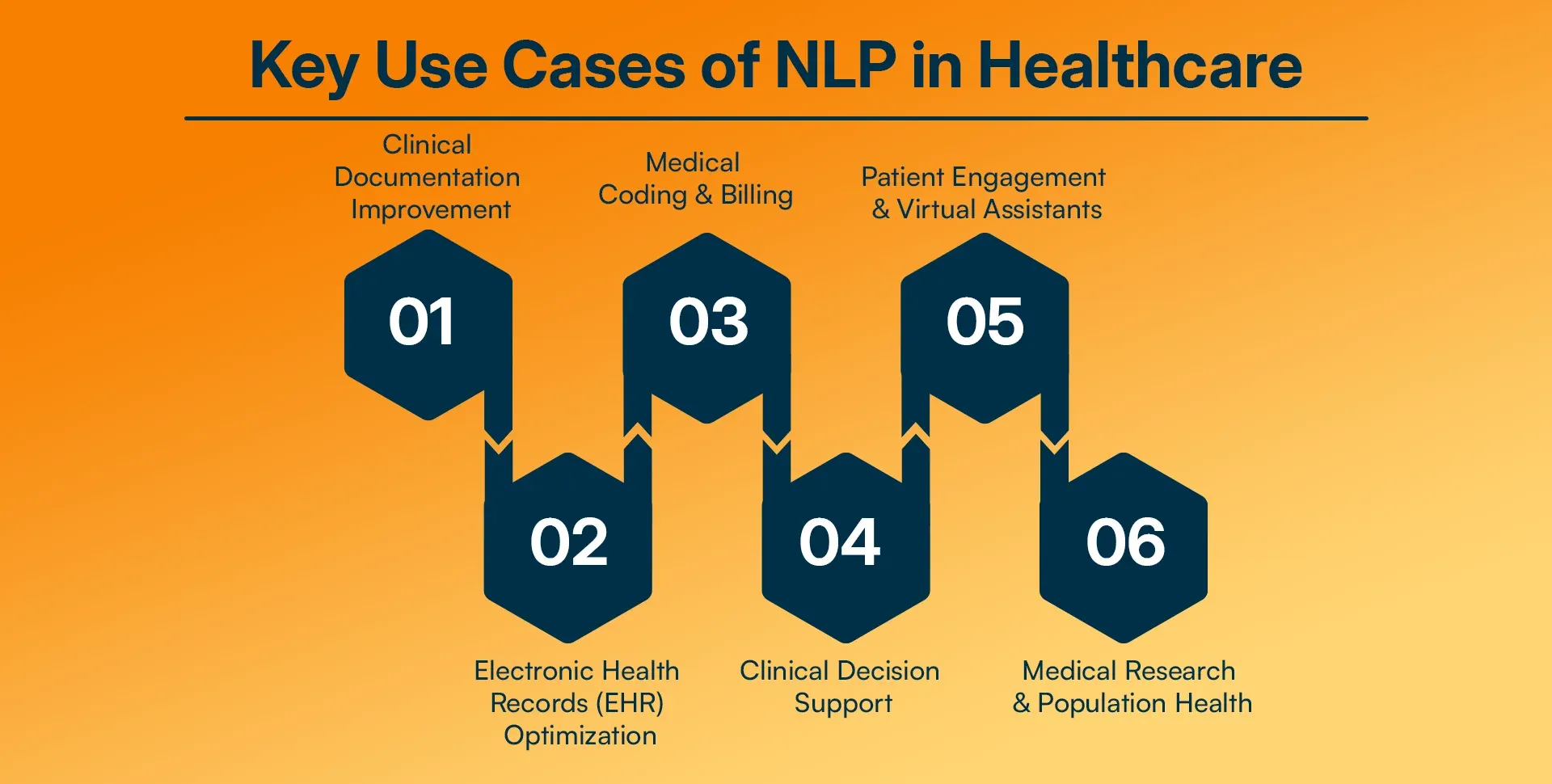
1. Clinical Documentation Improvement
Physicians spend nearly half their workday on EHR and desk work; no wonder burnout is rampant. Tools like Nuance Dragon Medical One use NLP to transcribe doctor–patient conversations in real time, automatically generating clinical notes. I’ve watched doctors’ shoulders literally relax when they realize they can focus on patients instead of typing.
2. Electronic Health Records (EHR) Optimization
Unstructured clinical notes often hide crucial facts. Systems like Epic’s NLP-powered EHR convert free-text into structured insights, making patient records searchable and actionable. This not only speeds up care decisions but also supports population health management and value-based care initiatives.
3. Medical Coding & Billing
Computer-Assisted Coding (CAC) uses NLP to assign accurate billing codes from doctors’ notes. While adoption is still around 30%, my clients who implemented CAC saw faster claims processing and reduced manual errors, a direct boost to revenue cycle management.
4. Clinical Decision Support
NLP helps identify patterns in patient data to support diagnosis. For example, Isabel Healthcare and IBM Watson have used NLP to detect infections or recommend treatment options by scanning vast medical literature. I’ve seen NLP-driven decision support cut diagnostic turnaround times from days to minutes.
5. Patient Engagement & Virtual Assistants
Healthcare chatbots powered by NLP, think of BRIGHT.MD’s Smart Exam or mental-health bots like Woebot can triage symptoms, book appointments, or even offer therapeutic conversations. These virtual assistants reduce wait times and improve patient satisfaction, especially for routine queries.
6. Medical Research & Population Health
NLP is a game-changer for data mining in clinical research. It accelerates clinical trial matching and identifies population-level trends in public health. I’ve worked with research teams who used NLP to flag early signs of disease outbreaks from EHR data and even social media posts.
Benefits of NLP in Healthcare
NLP is contributing a lot to the AI assistants and LLM models that we use today, because if NLP was not there, we would not be able to converse with Chatbots so easily, so let us learn about the benefits of NLP in the healthcare sector.
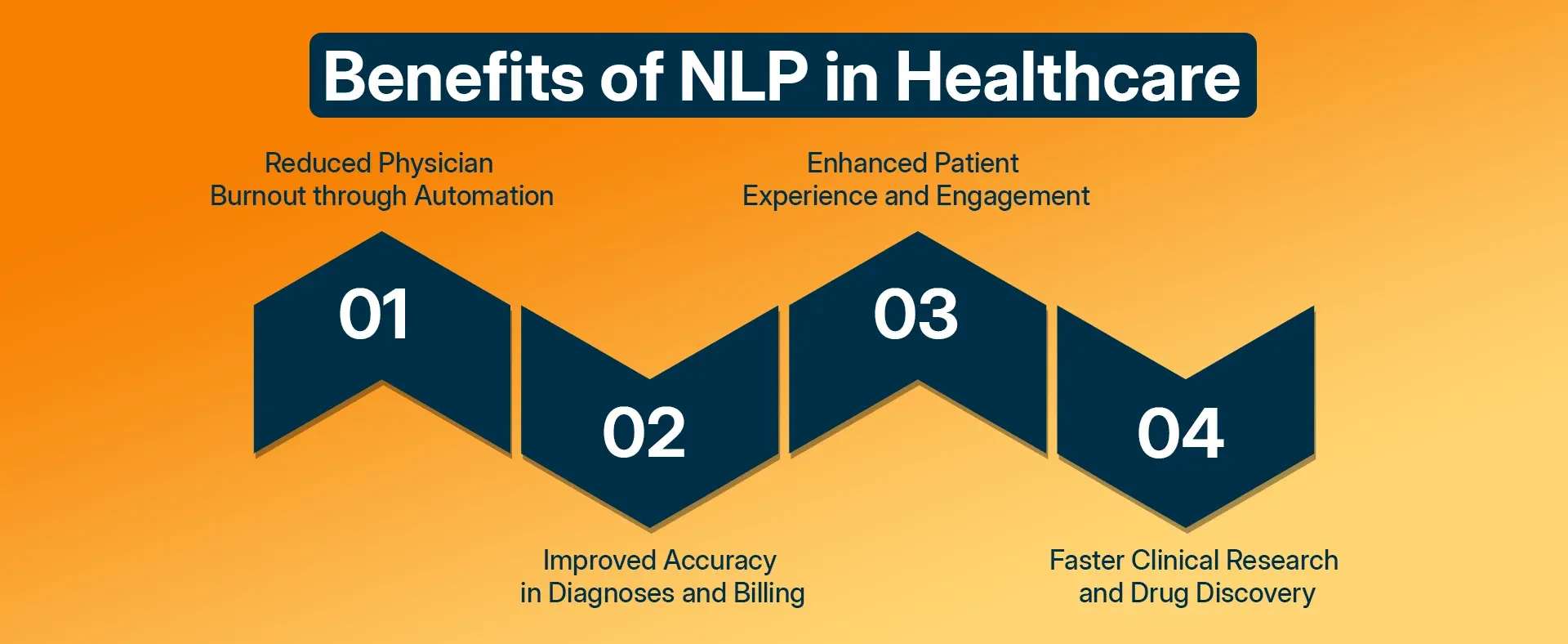
-
Reduced Physician Burnout through Automation
By handling documentation, coding, and administrative tasks, NLP allows doctors to spend more time with patients. Several hospitals I’ve worked with reported a double-digit drop in burnout rates after rolling out speech-to-text NLP systems.
-
Improved Accuracy in Diagnoses and Billing
NLP minimizes human error in coding and helps physicians spot patterns they might otherwise miss. This leads to more precise diagnoses and fewer denied insurance claims.
-
Enhanced Patient Experience and Engagement
From chatbots that answer questions instantly to personalized health recommendations, NLP-driven tools make healthcare more patient-friendly. Patients appreciate faster responses and clearer communication.
-
Faster Clinical Research and Drug Discovery
Researchers can analyze massive volumes of clinical trial data and scientific literature in a fraction of the time. NLP has already helped pharmaceutical companies identify new drug candidates and shorten research timelines.
Real-World Case Studies: NLP in Action
As we know that NLP supports multiple industries be it academic sector or healthcare sector, let us learn about the real world use cases of NLP so that we can understand NLP better.
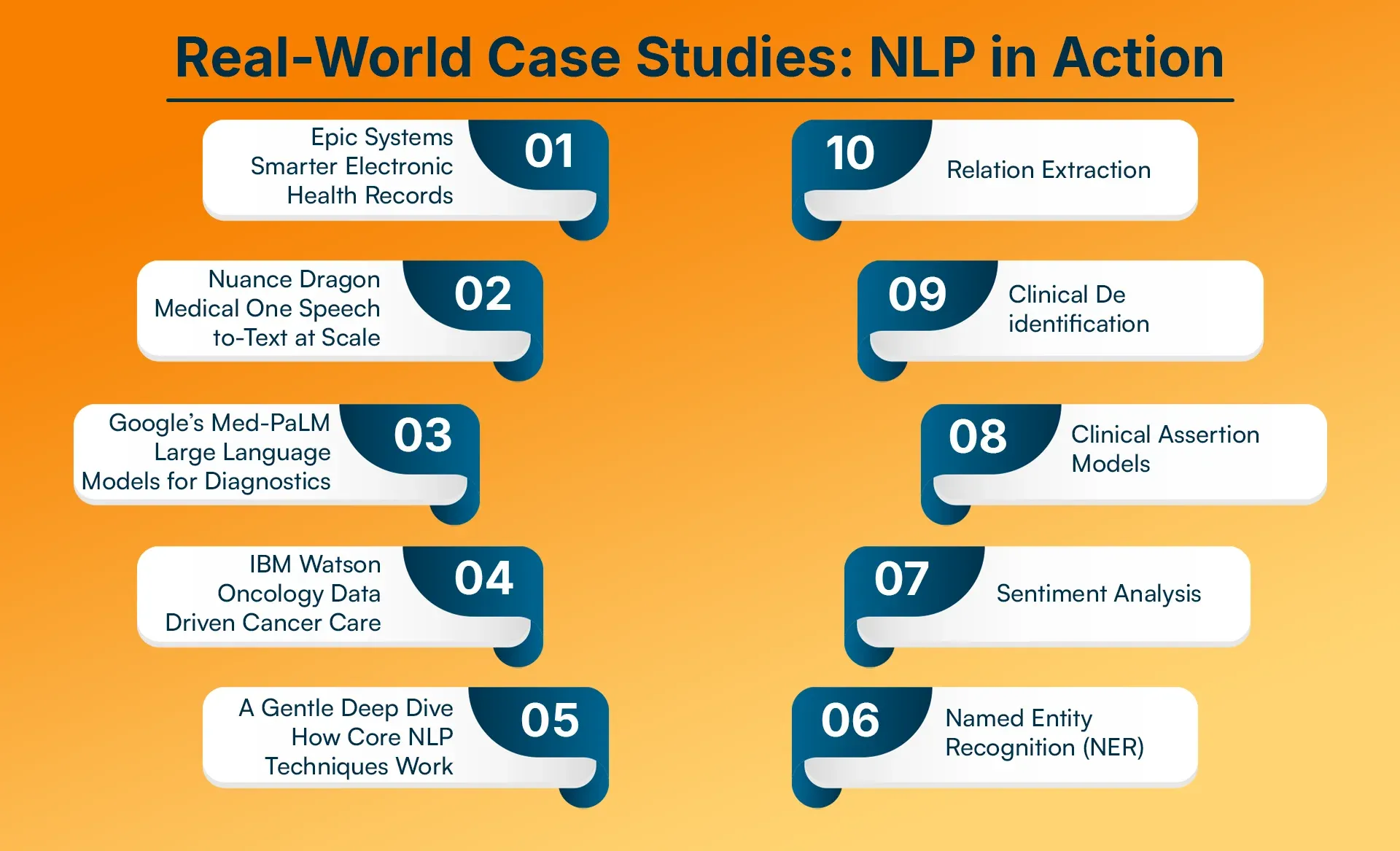
1. Epic Systems – Smarter Electronic Health Records
Epic has embedded NLP across its EHR platform to extract key details from free-text clinical notes. In practice, this means a physician can search for “previous cardiac events” and the system will surface every relevant note, even if those words never appear verbatim. At one hospital I advised, Epic’s NLP module cut the time spent gathering cardiac history from 40 minutes to less than 5, translating into faster diagnosis and more face-to-face patient care.
2. Nuance Dragon Medical One – Speech-to-Text at Scale
Nuance’s Dragon Medical One is a cloud-based speech recognition tool that has become a lifesaver for clinicians drowning in paperwork. During a pilot I observed, doctors dictated patient notes while examining the patient; the NLP system captured and structured the data in real time. The physicians reported a 30% reduction in end-of-day documentation workload, a major contributor to reduced burnout.
3. Google’s Med-PaLM – Large Language Models for Diagnostics
Google’s Med-PaLM, a medically tuned large language model, can answer complex clinical questions and generate evidence-based recommendations. When tested by physicians, it demonstrated a high level of accuracy in explaining rare conditions and suggesting next steps. While still under careful evaluation, it’s a glimpse into how generative AI could become a trusted second opinion in the exam room.
4. IBM Watson Oncology – Data-Driven Cancer Care
IBM Watson for Oncology analyzes vast datasets, medical literature, clinical trial results, and patient records to suggest personalized treatment plans. Oncology teams use Watson’s recommendations as a starting point for case discussions. Although Watson’s commercial momentum has slowed, its early work demonstrated that NLP can process decades of cancer research in seconds, supporting more informed decision-making.
5. A Gentle Deep Dive: How Core NLP Techniques Work
There are many types of NLP models and these vary from industry to industry and different NLP techniques are used in different industries, let us know how core NLP techniques work.
6. Named Entity Recognition (NER)
NER identifies and classifies specific terms, like diseases, medications, or lab tests, within clinical text. For instance, in the sentence “Patient diagnosed with type 2 diabetes and prescribed metformin,” NER would tag “type 2 diabetes” as a condition and “metformin” as a medication. Healthcare NER models are trained on vast sets of annotated clinical notes so they can accurately spot terms even when doctors use abbreviations or synonyms.
7. Sentiment Analysis
Although commonly used in marketing, sentiment analysis is increasingly valuable in healthcare. It helps providers monitor patient satisfaction by analyzing survey responses or social media posts. Advanced sentiment models don’t just label text as positive or negative; they assess context, detecting frustration in phrases like “I waited forever, but the nurse was kind.”
8. Clinical Assertion Models
These models determine whether a medical problem is present, absent, or conditional. Imagine a doctor writes: “No evidence of pneumonia, but watch for fever.” An assertion model will mark “pneumonia” as absent and “fever” as conditional. This precision is crucial for accurate diagnoses and billing.
9. Clinical De-identification
Before sharing patient records for research, identifying information must be removed. NLP-powered de-identification scans text for protected health information, names, addresses, phone numbers, and replaces them with tags like [NAME] or [ADDRESS], ensuring HIPAA compliance.
10. Relation Extraction
Sometimes it’s not just the entities but their relationships that matter, such as which medication treats which condition. Relation extraction models identify these links, helping build structured knowledge graphs for clinical decision support.
These techniques typically rely on a combination of rule-based systems and machine learning models. Early systems leaned heavily on handcrafted rules. Today’s state-of-the-art approaches use deep learning, particularly transformer architectures (like BERT or GPT-style models), which can capture subtle context and learn from enormous amounts of text.
Challenges and Limitations
As we know that no technology is ever flawless, and Artificial Intelligence and NLP are still evolving, hence there are many challenges and limitations in it, let us know about it in detail.
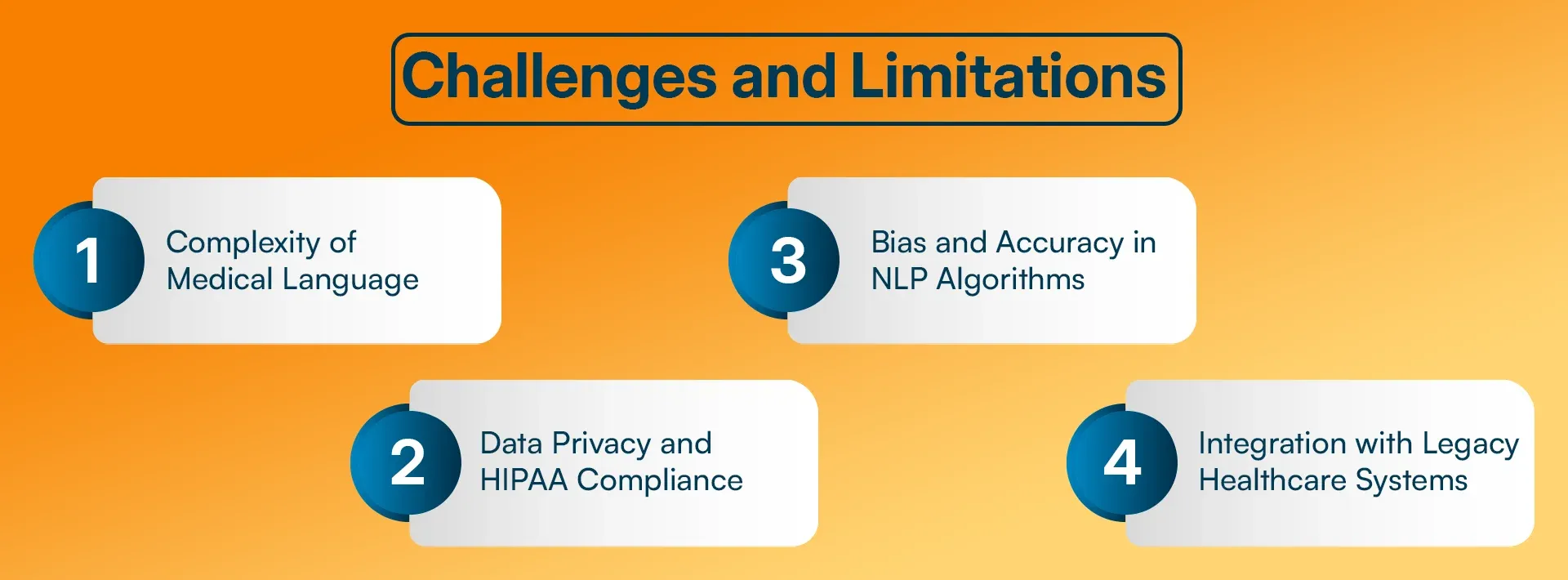
1. Complexity of Medical Language
Medicine is full of abbreviations, synonyms, and context-dependent terms. For example, “SOB” might mean “shortness of breath”, or something else entirely. NLP systems must be carefully trained to interpret these nuances.
2. Data Privacy and HIPAA Compliance
Healthcare data is highly sensitive. Any NLP implementation must comply with HIPAA and similar regulations worldwide. Balancing innovation with strict data privacy is a constant challenge.
3. Bias and Accuracy in NLP Algorithms
If the training data is biased, the model’s recommendations may be skewed. Continuous monitoring and diverse datasets are critical to maintain fairness and accuracy.
4. Integration with Legacy Healthcare Systems
Many hospitals still run on older EHR systems. Integrating modern NLP tools often requires custom development and change management to avoid disrupting workflows.
Future of NLP in Healthcare
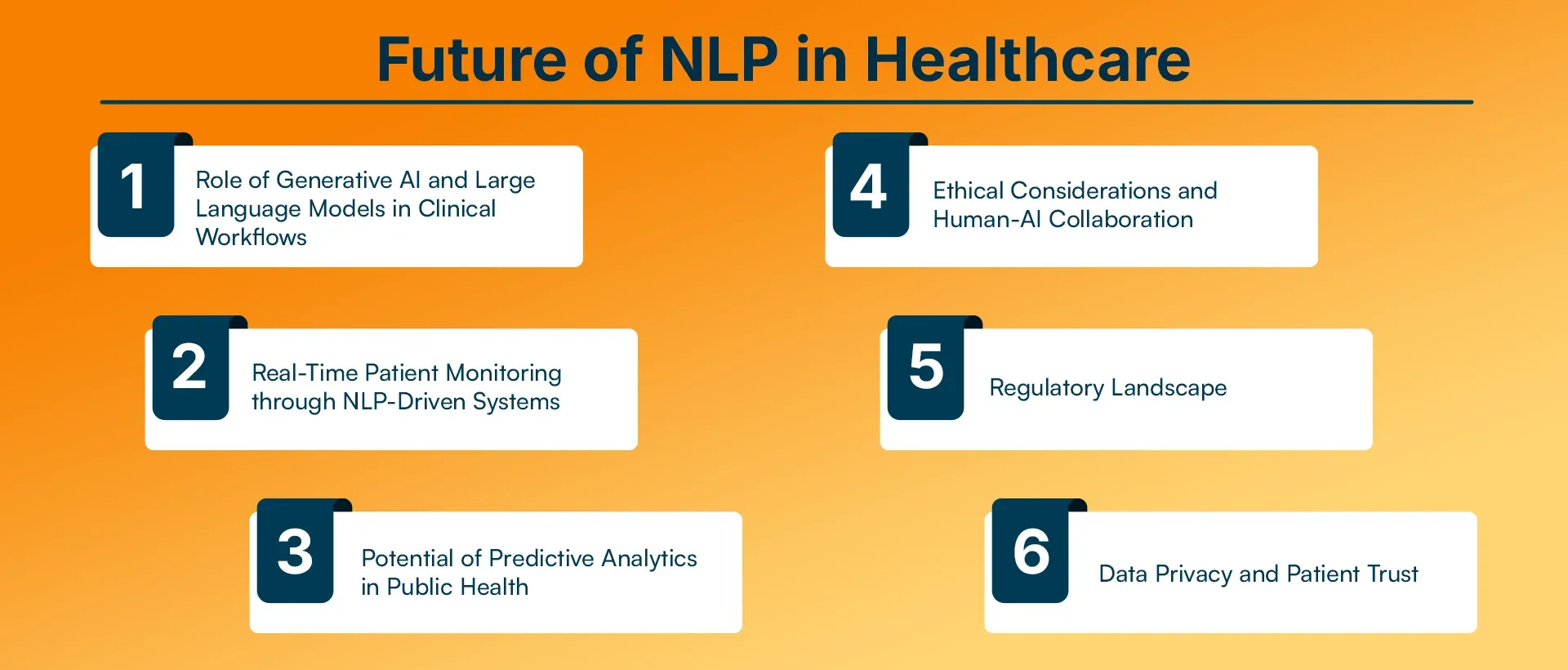
-
Role of Generative AI and Large Language Models in Clinical Workflows
Next-generation LLMs like Med-PaLM and GPT-4o can summarize patient records, draft discharge letters, or even suggest treatment plans. This could dramatically cut documentation time while enhancing decision-making, provided we maintain strict human oversight to prevent “hallucinations.”
-
Real-Time Patient Monitoring through NLP-Driven Systems
Imagine continuous analysis of patient speech or wearable device data to detect early signs of deterioration, like subtle changes in breathing patterns. Early pilots are already exploring this space.
-
Potential of Predictive Analytics in Public Health
By combining NLP with predictive analytics, hospitals can identify high-risk patients for conditions like heart failure or infections. In one French study, an NLP algorithm predicted hospital readmissions with 97.45% positive predictive value.
-
Ethical Considerations and Human-AI Collaboration
As AI takes on more clinical tasks, we must address issues of transparency, accountability, and patient consent. I believe the future is human-AI collaboration, not replacement, where NLP augments clinicians’ capabilities without taking away their judgment.
-
Regulatory Landscape
Governments are moving quickly to keep pace with AI in healthcare. In the United States, the FDA is exploring frameworks for approving AI-driven clinical decision support tools. In the EU, the AI Act proposes strict risk-based oversight, including requirements for explainability and bias testing.
For hospital leaders, staying compliant will mean closer collaboration between legal, clinical, and technical teams.
-
Data Privacy and Patient Trust
Patients are increasingly aware of how their data is used. Building trust means not just meeting the letter of HIPAA or GDPR but clearly communicating to patients how their information powers better care, and giving them control over what is shared.
Conclusion
Machine learning and NLP have become practical concepts today, with many medical hospitals, organizations, and researchers using NLP-based tools and technology to make systems and patients more structured and organized. Doctors, from physicians to surgeons, use it for quicker treatment.
Artificial intelligence makes patient data universally accessible to all hospitals, giving them a comprehensive view of a patient's past medical records.
NLP models are still evolving, which is why companies try to use firms like RejoiceHub for proper customisation or NLP-based chatbots. Because inexperienced skills can pose significant challenges for businesses, always deploy through reputable firms.
Frequently Asked Questions
1. What is an example of NLP in healthcare?
Computer-Assisted Coding (CAC) is a prime example, as it uses NLP to automatically assign billing codes using clinical notes. This saves manual costs and significantly reduces the chance of errors.
2. How does NLP reduce physician burnout?
It automates documentation and supports voice-to-text clinical note generation, allowing doctors to focus on patient care instead of paperwork.
3. Is NLP secure for patient data?
Almost yes. If NLP is properly trained and follows HIPAA and GDPR guidelines, and provides strong encryption and access controls, it can keep sensitive information safe and secure.
4. Can NLP help with clinical trial recruitment?
Absolutely, because NLP models can scan EHRs to identify patients who meet eligibility criteria, dramatically speeding up trial matching. This can help patients get their treatment faster, as their past patient data will already be available at hospitals' P&S.
5. What are the main challenges of NLP in healthcare?
Complex medical language, integration with legacy systems, data privacy regulations, and algorithmic bias are the major issues.
6. How is generative AI influencing NLP in healthcare?
Large language models are making clinical summarization and patient communication more natural and efficient, but also require careful checks so that inaccuracies can be avoided.
7. What's next for NLP in healthcare?
In the future, NLP used in healthcare will support real-time patient monitoring, predictive analytics, and apart from this, they will also use tighter regulatory frameworks to ensure ethical AI deployment.
